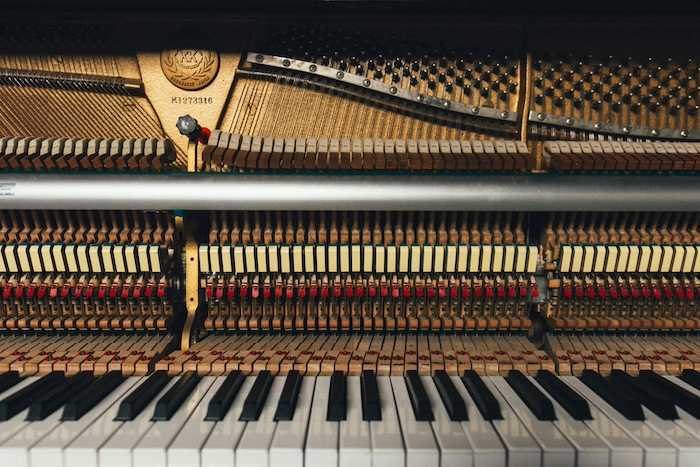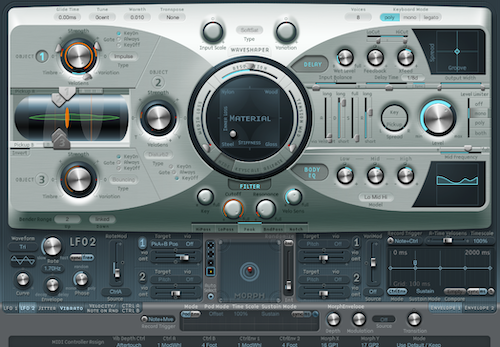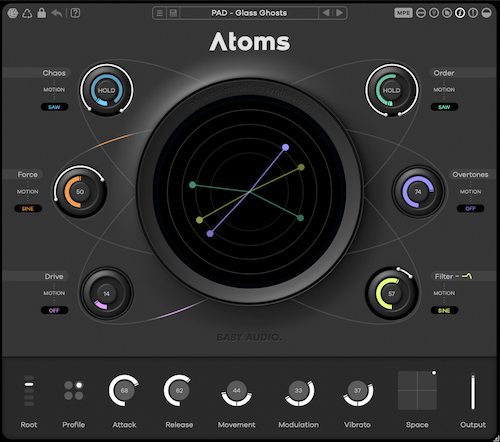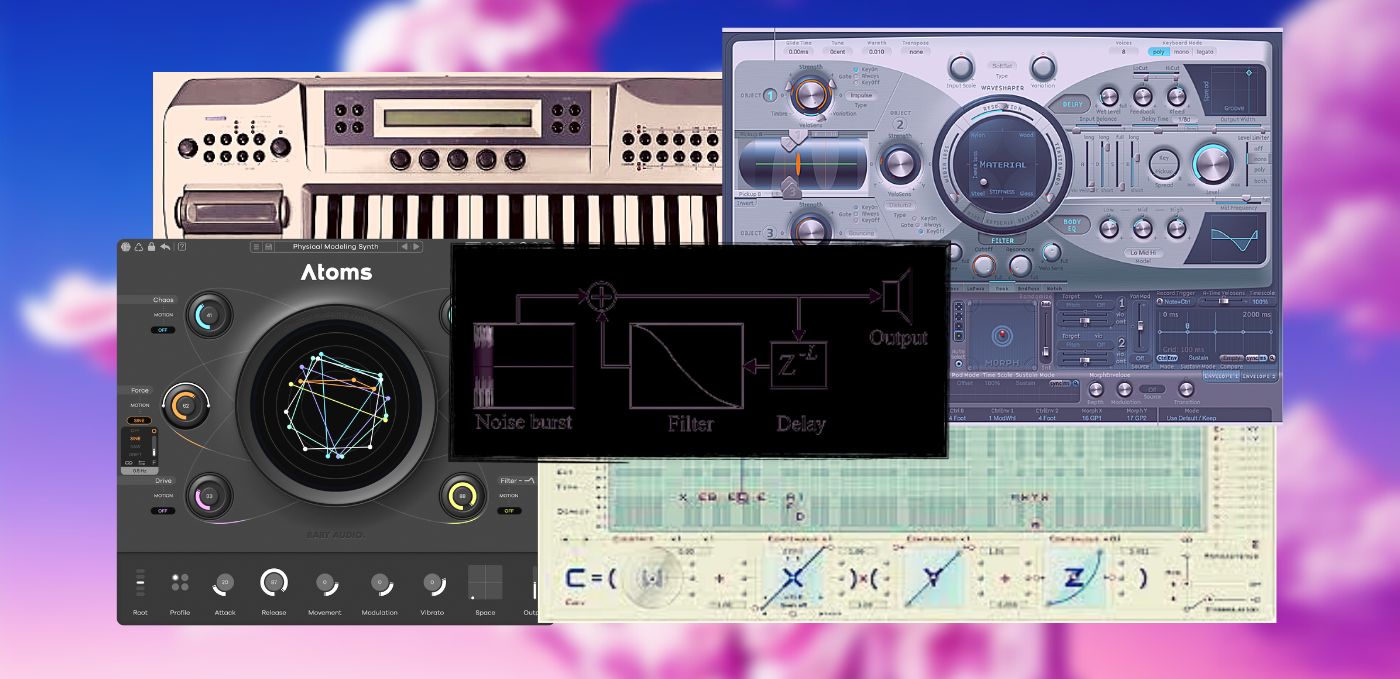Once a niche form of synthesis, physical modelling is now growing in popularity, offering both highly realistic – and wildly novel – results.
The history of sound synthesis has two, opposing parts: the strive towards realism and the drive to create other-worldly and never-before-heard sounds. Analogue synthesis kicked things off with Bob Moog aiming to recreate the sound of the orchestra and Don Buchla pushing traditional musicality away like a Drake meme. Physical modelling is another such form of synthesis, capable of both astonishing, acoustic realism and outrageous new sounds.
Born in the 1980s but, thanks to affordable components and ever-more powerful computers, it’s now become a viable synthesis alternative for synthesizers, both hardware and soft. Need realistic violins? Done. Want to conceptualize a grouping of springs and masses and play it with a virtual bow? That exists now with Baby Audio’s Atoms. And, with more instruments debuting all the time with PM elements, physical modelling synthesis is finally ready for its close-up. But how did we get here?
What Is Physical Modelling?
There are a number of different types of physical modelling synthesis but, in general, PM is a digital and mathematical recreation of the sound properties of acoustic instruments. Of course, it doesn’t have to be an existing instrument, which is one of the benefits of physical modelling.

In general, there are two components to a physical model: an exciter and a resonator. Think of how a musical instrument works. There’s the thing that causes the sound (a hand, a bow, breath) and the thing that makes the sound (the body of a drum, the string and wooden parts of a violin, a flute). These are the exciter and resonator.
Where things get interesting – and this is where you need the computational power – is all the variation that these two elements can create. Playing a guitar string at the bottom of the neck will sound different than at the top. Change the properties of the body from wood to, say, metal and things change again. Not to mention all the vibration. Even if you hit a drum in the exact same spot every time, there will still be variations in the sound due to the complex nature of vibrations.
Physical modelling is another such form of synthesis, capable of both astonishing, acoustic realism and outrageous new sounds.
Physical Modelling Roll Call
While physical modelling began in the analogue world with speech synthesis (which we covered in a different article), PM as we know it kicked off in the 1980s at the Center For Computer Research In Music and Acoustics (CCRMA) at Stanford University with Karplus-Strong synthesis. Named after the two people who developed it, Karplus-Strong is a method to recreate the sound of vibrating strings via a simple noise burst exciter and feedback loop resonator. Dr. Julius Orion Smith III later expanded this into digital waveguide synthesis.
Another type of PM is modal synthesis. Useful for replicating percussive sounds like bells and mallet instruments, modal synthesis uses a parallel bank of resonators to create sound.
As mentioned earlier, while PM is great at replicating the sound of actual physical instruments, there are applications above and beyond this. One is mass-interaction networks, which virtually model complex vibrating structures to create sound.
Physical Modelling: Hardware Advancements
By the late 1980s, it was clear that digital synthesis was here to stay. Yamaha had a hit with the DX7 and FM synthesis, originally licensed from Stanford University’s CCRMA. In 1989, Yamaha went back to school, working with Stanford jointly on digital waveguide synthesis. The result was the duophonic VL1, the world’s first hardware physical modelling synthesizer. Although powerful and incredible sounding, the 1993 synth was difficult to use, requiring a mastery of the instrument few were willing to invest in. It was also prohibitively expensive. Yamaha continued releasing PM instruments for a few years, convinced that PM would become the next big thing, but it never caught on.
Another early adopter of physical modelling was Korg. Combining PM with virtual analogue synthesis (itself an offshoot of PM developments), the monophonic Prophecy had a unique sound that found its way into tracks by The Prodigy and The Crystal Method. Korg later expanded the Prophecy into the 12-note polyphonic Z1, with its MOSS tone generator finding its way into versions of the Trinity and Triton.
Virtual analogue proved to be the much more popular application for physical modelling in the 1990s. Major manufacturers had largely abandoned pure PM by the end of the decade. Fast forward to the 2010s and the rise in popularity of Eurorack. Thanks to modules like Elements and Rings from Mutable Instruments, physical modelling began to seem like something interesting again.
A common application of PM now is as part of an array of synthesis techniques. Waldorf Iridium pairs it with wavetable, virtual analogue, granular and other digital methods. Likewise, Expressive E’s Osmose (which we called a ‘game-changer’) contains physical modelling as part of its Haken Audio-designed EaganMatrix sound engine.
It’s not just synths that incorporate physical modelling either. Korg’s Volca Drum employs a waveguide resonator in combination with a trigger waveform, wave folder and overdrive. Clavia’s Nord Drum series (now up to 3P) uses physical modelling synthesis in part to model acoustic drums.
Physical Modelling: Software Advancements

Physical modelling synthesis, as you’d expect given its digital nature, has also appeared in software form. One of the first, widely distributed PM synths was Sculpture in Logic Pro X. A fairly deep Karplus-Strong string synthesizer, it adds traditional synthesizer parameters to a robust PM section.
Logic Pro X isn’t the only DAW with stock PM instruments. Ableton Live has them too (in the Suite version), in the form of Collision, a virtual mallet instrument, and Tension, which does strings.
Collision and Tension come courtesy of developer Applied Acoustic Systems, which is famous for its physical modelling soft synths. Chromaphone (now up to version 3) features eight different acoustic resonators, from beams to tubes to plates. A recent PM synth, Reason Studios’ Objekt (Reason-only, unfortunately), uses three resonators to get the job done.
One of the benefits of physical modelling is that it can recreate acoustic instruments with surprising realism without the use of samples. One such example is Piano V from Arturia, which allows you to change parameters like harmonics and even piano material (fancy a glass piano?) easily.
One of the benefits of physical modelling is that it can recreate acoustic instruments with surprising realism without the use of samples..

Of course, part of the fun of physical modelling is creating brand-new instruments. One way is by changing the material of an existing instrument, like a piano in Piano V. Another is by imagining an entirely new structure for the instrument, as with Baby Audio’s Atoms. Based on a mass-spring interaction, it lets you ‘play’ the mass with a bow and create all sorts of unique timbres and tones. The plugin gives you control over parameters like Chaos, Order, Force of the bow and Overtones to shape the sound, as well as traditional synthesizer functionality such as a filter and envelope – although these are actually all done with physical modelling itself.
Here are a few examples of Atoms in action:
Bowed metal:
Physically modelled bassline:
Unusual plucked strings:
Scary pad:
As computational power increases, expect physical modelling to become more common and ever more realistic. The possibility for bizarre new instruments capable of unique sounds like Atoms is definitely exciting.
While you’re here, we mention that the DX7 was difficult to program, something we made a joke about.
